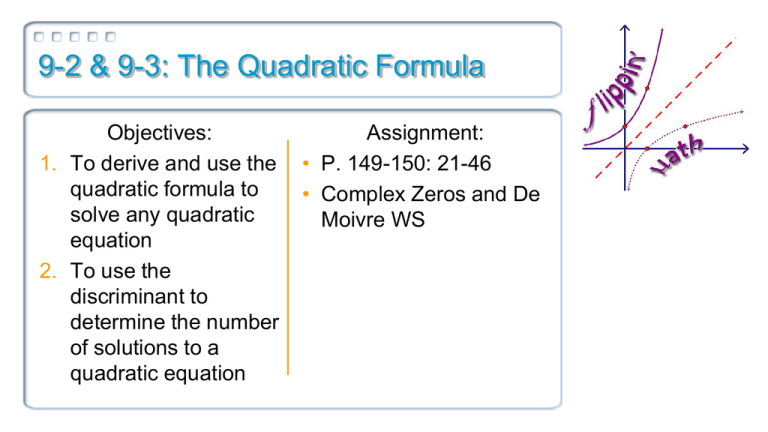9-2 & 9-3: The Quadratic Formula
advertisement

9-2 & 9-3: The Quadratic Formula Objectives: 1. To derive and use the quadratic formula to solve any quadratic equation 2. To use the discriminant to determine the number of solutions to a quadratic equation Assignment: • P. 149-150: 21-46 • Complex Zeros and De Moivre WS Warm-Up In the equation shown, for what values of c does the equation have 2 real solutions, 2 imaginary solutions, or 1 real solution? x2 8x c 0 Objective 1 You will be able to derive and use the quadratic formula to solve any quadratic equation Exercise 1 Solve by completing the square. 3x2 + 8x – 5 = 0 Investigation: A Formula Solving a quadratic equation by completing the square is quite useful since it allows you to solve just about any quadratic equation. However, it can be cumbersome and tedious, especially if there are ungainly fractions involved. What we need is a formula. Investigation: A Formula On your own, try to derive the quadratic formula. To do this, try completing the square on the general quadratic equation in standard form as shown below. Even though there are variables everywhere, the technique is still the same as if the a, b, and c were good old-fashioned numbers. ax2 + bx + c = 0 Investigation: A Formula ax2 + bx + c = 0 The Quadratic Formula Let a, b, and c be real numbers, with a ≠ 0. The solutions to the quadratic equation ax2 + bx + c = 0 are x b b 2 4ac 2a Song 1: Song 2: Exercise 1 Write a quadratic equation in standard form that has the given solutions. 1. 9± 249 14 2. −3± 361 16 Objective 2 You will be able to use the discriminant to determine the number of solutions to a quadratic equation The Discriminant Discriminant In the quadratic formula, the expression b2 – 4ac is called the discriminant. Exercise 2 Find the values of k such that the equation has a) two real solutions, b) one real solution, and c) two imaginary solutions. x2 – 2kx + k = 0 9-2 & 9-3: The Quadratic Formula Objectives: 1. To derive and use the quadratic formula to solve any quadratic equation 2. To use the discriminant to determine the number of solutions to a quadratic equation Assignment: • P. 149-150: 21-46 • Complex Zeros and De Moivre WS



